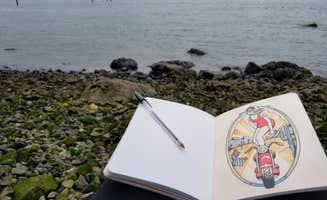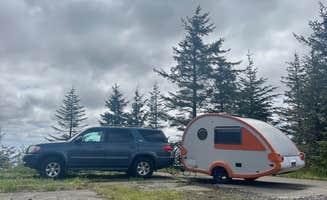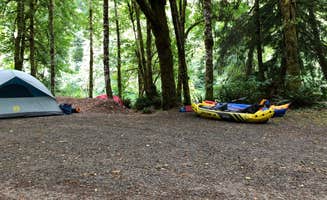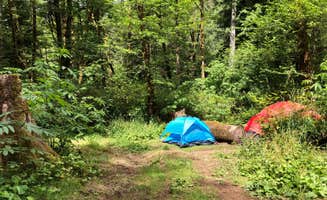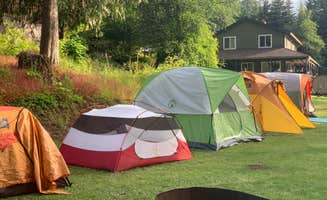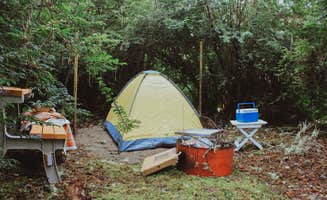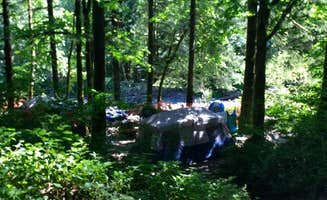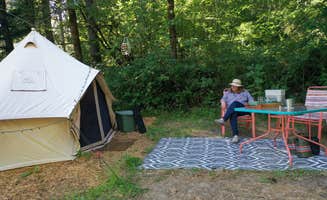Dispersed camping options near Cathlamet, Washington offer campers access to several remote forest locations within an hour's drive. The area sits at the intersection of coastal and inland forest ecosystems with elevations ranging from sea level along the Columbia River to 1,500 feet at higher dispersed sites. Weather conditions fluctuate drastically between seasons, with summer temperatures averaging 70-85°F and winter dropping to 30-45°F with frequent rainfall.
What to do
Fishing access: Creek areas frequently offer good fishing spots near campsites. At Cook Creek, campers can enjoy direct water access. "There is a sweet hike down to the river - absolutely gorgeous!" notes Shannon R., who visited site #5. Multiple fishing spots are accessible along the creek bed.
Wildlife watching: Morning hours provide the best opportunities to spot local wildlife. The Western Lake Campground area has active beaver populations. According to Lon, "When I was there, there were a couple of beaver working at the head of the lake." Early mornings offer the best viewing times before 8 AM.
Mountain viewpoints: Higher elevations around Cathlamet provide impressive vistas. While staying at Western Lake, campers can access viewpoints with expansive coastal views. "If you go farther up the road there is a viewpoint that lets you see clear to the coast on a sunny day," reports one visitor. These viewpoints require driving approximately 2-3 miles beyond the campground.
What campers like
Seclusion: Forested privacy is common at dispersed sites throughout the region. At Road to Snag Lake, "There are several spots off the road around these radio tower stations and it is quite secluded. We didn't see any other person the whole time we were there," writes Ryan S. Many campers appreciate the isolation despite the presence of communication towers.
River access: Creekside camping remains popular during summer months. The Tillamook Forest Dispersed on the Nehalem River offers multiple riverside camping spots. Jennifer R. reports, "Level spots were a little hard to come by, even on a Thursday, but we eventually found one. Stunning surroundings on the river." These sites typically fill quickly during weekends from June through September.
Night sky viewing: Clear conditions allow for excellent stargazing at higher elevation sites. Jeremy B. notes about Road to Snag Lake: "Great spot because it's so secluded in the forest. There's basically zero traffic on the dirt road near the campsite... Great view of the stars at night!" The best viewing typically occurs on clear nights between 10 PM and 2 AM, away from the coastal fog.
What you should know
Parking challenges: Site accessibility varies significantly by vehicle type and weather conditions. At Tillamook State Forest Dispersed Camping, Brendan warns: "My mistake, these coordinates took us to the top of the mountain. It is currently an active logging area, so the truckers are out at 3am. The road up was a very narrow road. So careful if there's other cars coming through, especially the logging semis."
Variable site conditions: Preparation needed for uneven terrain and seasonal changes. Cook Creek campers report mixed site conditions: "Large sites that would could host several tents. Creek is just 100ft away. Really close to main road so can be dusty and not super private," notes camper S.M. Most sites lack level areas for larger tents.
Permit requirements: Documentation needed at specific locations. Road to Snag Lake requires a Washington Discover Pass. Augusto P. clarifies, "This site is listed as free, but there is a sign at the entrance for needing a discovery pass to use the site. Visit their website for payment options. You have to print the pass or write the transaction number on a paper and on your windshield."
Tips for camping with families
Creek exploration: Shallow water areas provide safe recreation for children during summer months. Mariah W. shares about Cook Creek: "The foliage was lovely, we could hear a variety of birds and the creek nearby—such a relaxing space... There is lots to explore nearby, and it's a reasonable drive to Manzanita if you want to visit the coast." Most creek areas maintain shallow depths under 2 feet during normal conditions.
Site selection: Arrive early to secure the best family-friendly spots, especially during peak season. At Clatsop State Forest Gnat Creek Campground, Morgan T. advises, "Each site has a picnic table and fire pit. Walk in tent camping only... Sites are among the trees and you can hear the creek from your tent." Family-appropriate sites typically fill by noon on summer weekends.
Limited facilities: Pack accordingly for minimal amenities at most dispersed sites. Stephanie Z. notes about Gnat Creek: "There isn't a ton here, but there are the necessities - a place to put your tent for the night and a bathroom. We also took advantage of where we wound up and did a short hike which led to a fish hatchery." Families should bring portable toilet supplies for most dispersed camping locations.
Tips from RVers
Access limitations: Size restrictions affect most tent camping areas near Cathlamet. At Gnat Creek, Kathy B. warns: "Also there is a sign that says no RVs, campers or trailers. I was a bit nervous that I would be asked to leave in my van, but never saw a ranger or anyone official." Smaller vehicles under 20 feet generally have more options than larger rigs.
Alternative parking: Remote dispersed areas sometimes accommodate smaller RVs despite restrictions. Michael P. reports about Tillamook State Forest: "I setup camp at one of the spots here 3 nights in a row & had no visitors the entire time! Very quiet & can hear some noise in the distance from time to time, but was pleasantly surprised by the peace & quiet I got up here." Most sites limit parking to one or two vehicles regardless of size.
Road conditions: Weather-dependent access affects RV travel throughout the region. Road to Snag Lake reviews note varying conditions: "The road getting here is a bit rough with lots of washboard, steep grades and rocks. But it's fun. No amenities, obviously, but there is a concrete pad from an old structure you can park on." Roads typically worsen after rain events, with standing water common in low areas.



